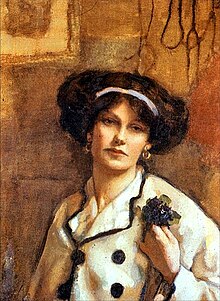Norah Neilson Gray
| Norah Neilson Gray | |
|---|---|

self portrait (1918)
|
|
| Born |
16 June 1882 Helensburgh |
| Died | 27 May 1931 (aged 48) Glasgow |
| Cause of death | cancer |
| Nationality | British |
| Education | Glasgow School of Art |
| Occupation | painter |
| Known for | portraits |
Norah Neilson Gray (16 June 1882 – 27 May 1931) was a British artist of the Glasgow School. She was a member of The Glasgow Girls whose paintings were exhibited in Kirkcudbright in July and August 2010.
Gray was born at Carisbrook on West King Street in Helensburgh in 1882 to George Gray, a Glasgow ship owner, and his wife, Norah Neilson. She was first privately taught by two local art teachers. Gray and her family then moved to Glasgow in 1901 so she could attend the Glasgow School of Art until 1906. She trained under the Belgian Jean Delville and Fra Newbery. She taught fashion-plate drawing at the school from 1906.
Gray also taught at St. Columba's in Kilmacolm which at the time was a girls' school. Miss Gray was said to have been nicknamed "Purple Patch", because of her insistence that colours could be seen in shadows if you looked correctly. Gray was exhibiting by 1910 and had her own studio where she painted portraits.
During World War One, Gray volunteered as a nurse with the Scottish Women's Hospitals and was sent to France where she also found time to paint and sketch. A painting Hôpital Auxilaire 1918 from that time was offered to the Imperial War Museum but the Women's Work Sub-committee of the Museum refused to accept it and requested a painting showing a woman doctor instead. Hôpital Auxilaire 1918 shows the vaulted thirteenth century Royaumont Abbaye, near Paris, where women had organised a hospital to treat the casualties of the war. The hospital was staffed by Scottish Women's Hospitals, under the direction of the French Red Cross. Her second painting of Royaumont Abbaye, entitled The Scottish Women's Hospital In The Cloister of the Abbaye at Royaumont. Dr Frances Ivens inspecting a French patient was accepted by the IWM in 1920.
After World War One Gray returned to her work as a portraitist, most commonly painting young women and children. In 1921 and 1923 she was given a medal for her painting, The Belgian in Exile which she had completed in 1915. That picture shows a Belgian refugee from Liege who had fled to Scotland after his country was invaded. Gray was chosen to be the first woman to join the influential hanging committee of the Royal Glasgow Institute of the Fine Arts. Gray died in Glasgow at the age of 48 on 27 May 1931 of cancer.
...
Wikipedia
